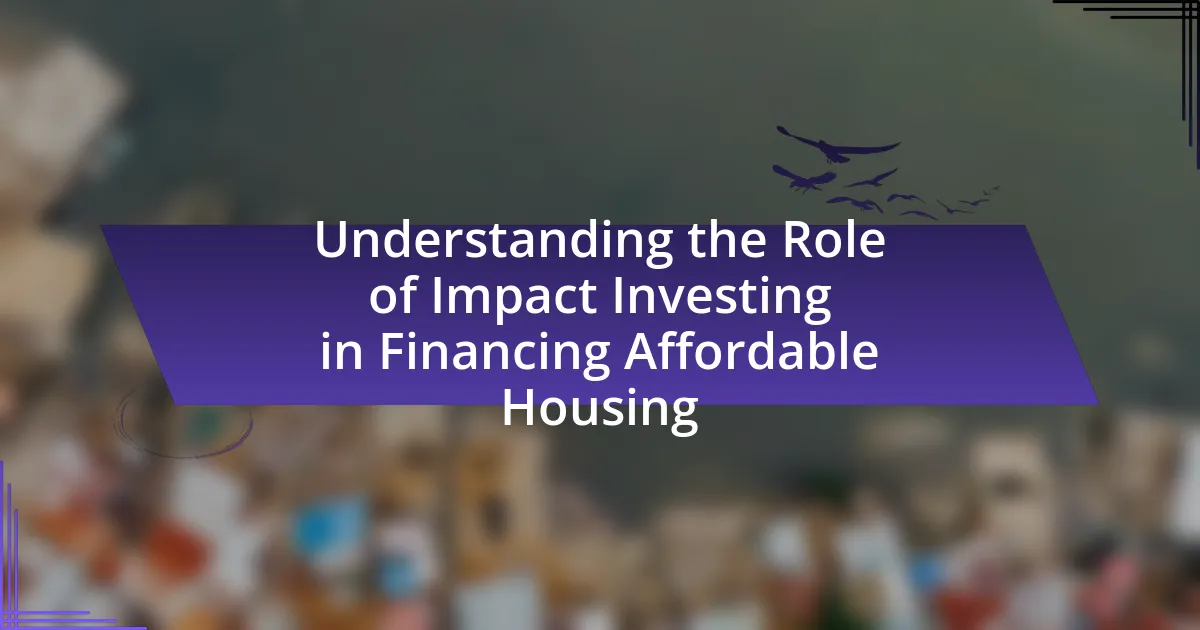Impact investing in affordable housing is a strategy that aims to generate social and environmental benefits alongside financial returns by increasing the availability of affordable housing options for low- and moderate-income individuals and families. This article explores the differences between impact investing and traditional investing, highlighting key principles such as intentionality, financial return, and measurable impact. It addresses the importance of affordable housing in today’s economy, the social implications of inadequate housing, and the challenges faced in financing affordable housing projects. Additionally, it discusses effective strategies for impact investing, the role of community organizations, and the metrics used to evaluate the success of these investments, ultimately emphasizing the potential for impact investing to contribute to economic stability and community development.

What is Impact Investing in Affordable Housing?
Impact investing in affordable housing refers to investments made with the intention of generating social and environmental impact alongside a financial return, specifically aimed at increasing the availability of affordable housing options. This approach addresses the critical need for affordable housing by directing capital towards projects that provide housing solutions for low- and moderate-income individuals and families. According to the Global Impact Investing Network, impact investments in housing can lead to improved living conditions, community development, and economic stability, thereby contributing to broader social goals while also offering potential financial returns to investors.
How does impact investing differ from traditional investing?
Impact investing differs from traditional investing primarily in its dual focus on financial returns and social or environmental impact. While traditional investing prioritizes maximizing financial profit without necessarily considering social outcomes, impact investing intentionally seeks to generate measurable positive effects alongside financial gains. For instance, a study by the Global Impact Investing Network (GIIN) indicates that impact investors are motivated by both the potential for financial returns and the desire to address social issues, such as affordable housing, climate change, and education. This distinction highlights that impact investing integrates purpose with profit, aiming to create a sustainable and equitable future.
What are the key principles of impact investing?
The key principles of impact investing include intentionality, financial return, and measurable impact. Intentionality refers to the commitment to generate positive social and environmental outcomes alongside financial returns. Financial return emphasizes the expectation of a financial profit, which can vary from below-market to market-rate returns. Measurable impact involves the use of metrics to assess the social and environmental effects of investments, ensuring accountability and transparency. These principles guide investors in aligning their financial goals with their desire to contribute to societal challenges, such as affordable housing.
How does impact investing specifically target affordable housing?
Impact investing specifically targets affordable housing by directing capital towards projects that provide low-income individuals and families with access to safe and affordable living conditions. This investment strategy focuses on generating measurable social impact alongside financial returns, often through the development or rehabilitation of affordable housing units. For instance, according to the Global Impact Investing Network, impact investments in affordable housing can yield both a financial return and a significant reduction in housing insecurity, addressing the critical need for affordable living spaces in urban areas.
Why is affordable housing important in today’s economy?
Affordable housing is crucial in today’s economy because it directly impacts economic stability and growth. Access to affordable housing enables low- and middle-income families to allocate more of their income towards essential goods and services, thereby stimulating local economies. According to the National Low Income Housing Coalition, there is a shortage of 7 million affordable rental homes for extremely low-income renters, which exacerbates poverty and limits economic mobility. Furthermore, affordable housing contributes to healthier communities, reducing healthcare costs and improving educational outcomes, as families are less burdened by housing costs. This interconnectedness of housing affordability and economic health underscores its importance in fostering a resilient economy.
What are the social implications of inadequate affordable housing?
Inadequate affordable housing leads to significant social implications, including increased homelessness, social instability, and diminished community cohesion. When affordable housing is scarce, individuals and families are often forced into overcrowded or substandard living conditions, which can exacerbate health issues and limit access to essential services. According to the National Low Income Housing Coalition, there is a shortage of 7 million affordable rental homes for extremely low-income renters in the United States, highlighting the critical need for affordable housing solutions. This shortage contributes to rising poverty levels and can lead to increased crime rates as individuals struggle to secure stable living conditions. Furthermore, inadequate housing can hinder educational opportunities for children, perpetuating cycles of poverty and limiting social mobility.
How does affordable housing contribute to economic stability?
Affordable housing contributes to economic stability by providing low-income families with secure living conditions, which in turn enhances their ability to participate in the workforce and local economies. When families have access to affordable housing, they can allocate more of their income towards essential needs such as education, healthcare, and savings, rather than spending a disproportionate amount on housing costs. This financial relief fosters consumer spending, which is a key driver of economic growth.
Research from the National Low Income Housing Coalition indicates that for every $1 invested in affordable housing, there is a return of approximately $1.50 in economic activity, demonstrating the multiplier effect of housing investments on local economies. Furthermore, stable housing reduces the likelihood of homelessness and its associated costs to public services, thereby promoting overall economic health.
What challenges does impact investing face in financing affordable housing?
Impact investing faces several challenges in financing affordable housing, primarily including limited financial returns, regulatory hurdles, and the complexity of measuring social impact. Limited financial returns arise because affordable housing projects often yield lower profits compared to market-rate developments, making them less attractive to traditional investors. Regulatory hurdles include zoning laws and compliance with various local, state, and federal regulations, which can complicate project financing and development timelines. Additionally, measuring social impact is complex, as quantifying the benefits of affordable housing on communities requires robust metrics and data, which are often lacking. These challenges hinder the ability of impact investors to effectively allocate capital to affordable housing initiatives.
What are the common barriers to investment in affordable housing?
Common barriers to investment in affordable housing include high construction costs, regulatory challenges, and limited access to financing. High construction costs arise from rising material prices and labor shortages, making projects financially unviable. Regulatory challenges, such as zoning laws and lengthy approval processes, can delay projects and increase expenses. Limited access to financing is often due to perceived risks associated with affordable housing investments, leading to a lack of interest from traditional investors. These factors collectively hinder the development and availability of affordable housing options.
How do regulatory frameworks impact impact investing in this sector?
Regulatory frameworks significantly influence impact investing in the affordable housing sector by establishing guidelines that dictate investment practices and priorities. These frameworks can incentivize investments through tax credits, grants, or favorable zoning laws, which encourage developers to pursue affordable housing projects. For instance, the Low-Income Housing Tax Credit (LIHTC) program in the United States has been instrumental in financing affordable housing, resulting in the creation of over 3 million affordable housing units since its inception in 1986. Additionally, regulations that promote transparency and accountability in impact measurement can enhance investor confidence, leading to increased capital flow into the sector. Thus, effective regulatory frameworks not only shape the landscape of impact investing but also drive the allocation of resources towards affordable housing initiatives.
How can impact investing effectively finance affordable housing projects?
Impact investing can effectively finance affordable housing projects by directing capital towards developments that generate social and financial returns. This approach allows investors to support projects that meet community needs while also achieving a return on investment. For instance, funds specifically targeting affordable housing can leverage public-private partnerships, enabling developers to access low-interest loans or grants that reduce overall project costs. According to the Global Impact Investing Network, investments in affordable housing have shown a potential for stable cash flows and lower risk, making them attractive to impact investors. Additionally, the use of innovative financing mechanisms, such as social impact bonds, can further enhance funding for these projects, ensuring that they are both economically viable and socially beneficial.
What strategies can enhance the effectiveness of impact investing in affordable housing?
Strategies that can enhance the effectiveness of impact investing in affordable housing include leveraging public-private partnerships, utilizing data-driven decision-making, and focusing on community engagement. Public-private partnerships can mobilize additional resources and expertise, as evidenced by successful collaborations in cities like San Francisco, where such partnerships have led to the development of thousands of affordable units. Data-driven decision-making allows investors to assess market needs and track outcomes effectively, improving investment strategies; for instance, the use of geographic information systems (GIS) has helped identify areas with the greatest housing shortages. Community engagement ensures that developments meet the actual needs of residents, as demonstrated by initiatives in Boston that involve local stakeholders in the planning process, resulting in higher satisfaction and lower vacancy rates.
How can partnerships between investors and developers improve outcomes?
Partnerships between investors and developers can improve outcomes by aligning financial resources with innovative project execution, leading to enhanced efficiency and effectiveness in affordable housing initiatives. When investors provide capital, they enable developers to access necessary funding for projects that might otherwise be unfeasible. This collaboration often results in shared expertise, where investors bring financial acumen and risk management strategies, while developers contribute local market knowledge and construction experience.
For instance, a study by the Urban Land Institute highlights that projects funded through collaborative efforts between investors and developers often achieve higher occupancy rates and faster project completion times, demonstrating the tangible benefits of such partnerships. Additionally, these collaborations can lead to the development of housing that meets community needs more effectively, as both parties work together to identify and address local challenges.
What role do community organizations play in impact investing?
Community organizations play a crucial role in impact investing by acting as intermediaries that connect investors with local needs, particularly in affordable housing. These organizations identify community-specific challenges and opportunities, ensuring that investments align with the social and economic goals of the community. For instance, community organizations often conduct needs assessments and engage with residents to understand their priorities, which helps in directing funds towards projects that will have the most significant impact. According to a report by the Global Impact Investing Network, community organizations facilitate over 60% of impact investments in underserved areas, demonstrating their essential function in mobilizing resources for affordable housing initiatives.
What are the measurable outcomes of impact investing in affordable housing?
Measurable outcomes of impact investing in affordable housing include increased access to affordable units, improved living conditions, and enhanced community stability. Specifically, studies show that impact investments can lead to the creation of thousands of affordable housing units; for instance, the Low-Income Housing Tax Credit program has facilitated the development of over 3 million affordable homes since its inception. Additionally, impact investing often results in improved health outcomes for residents, as stable housing is linked to better physical and mental health, evidenced by research from the National Housing Conference which indicates that stable housing reduces healthcare costs by up to 20%. Furthermore, impact investments contribute to economic growth in communities, with a report from the Urban Institute highlighting that every $1 invested in affordable housing generates approximately $1.50 in economic activity.
How can success be defined and measured in these investments?
Success in impact investing for affordable housing can be defined and measured through specific metrics such as the number of housing units created, the affordability of those units relative to local income levels, and the social outcomes achieved, such as improved community well-being. For instance, a successful investment may be quantified by the creation of 500 affordable housing units that are priced at or below 30% of the area median income, thereby ensuring accessibility for low-income families. Additionally, measuring success can include tracking tenant satisfaction and stability, as well as reductions in homelessness rates in the targeted area, which can be substantiated by local government reports and housing studies.
What metrics are used to evaluate the impact of these investments?
Metrics used to evaluate the impact of investments in affordable housing include social return on investment (SROI), occupancy rates, and affordability ratios. SROI quantifies the social value created per dollar invested, providing a clear measure of impact. Occupancy rates indicate the effectiveness of housing projects in meeting demand, while affordability ratios assess the proportion of income spent on housing, ensuring that housing remains accessible to low-income families. These metrics collectively offer a comprehensive view of the effectiveness and social impact of investments in affordable housing.
What best practices should investors follow in impact investing for affordable housing?
Investors in impact investing for affordable housing should prioritize community engagement, rigorous due diligence, and measurable impact assessment. Community engagement ensures that the housing solutions meet the actual needs of residents, fostering trust and collaboration. Rigorous due diligence involves evaluating financial viability, regulatory compliance, and the social impact of projects, which is essential for sustainable investment. Measurable impact assessment allows investors to track outcomes and adjust strategies based on data, ensuring that investments lead to tangible benefits for low-income populations. According to the Global Impact Investing Network, effective impact measurement can enhance accountability and attract more capital to affordable housing initiatives.



